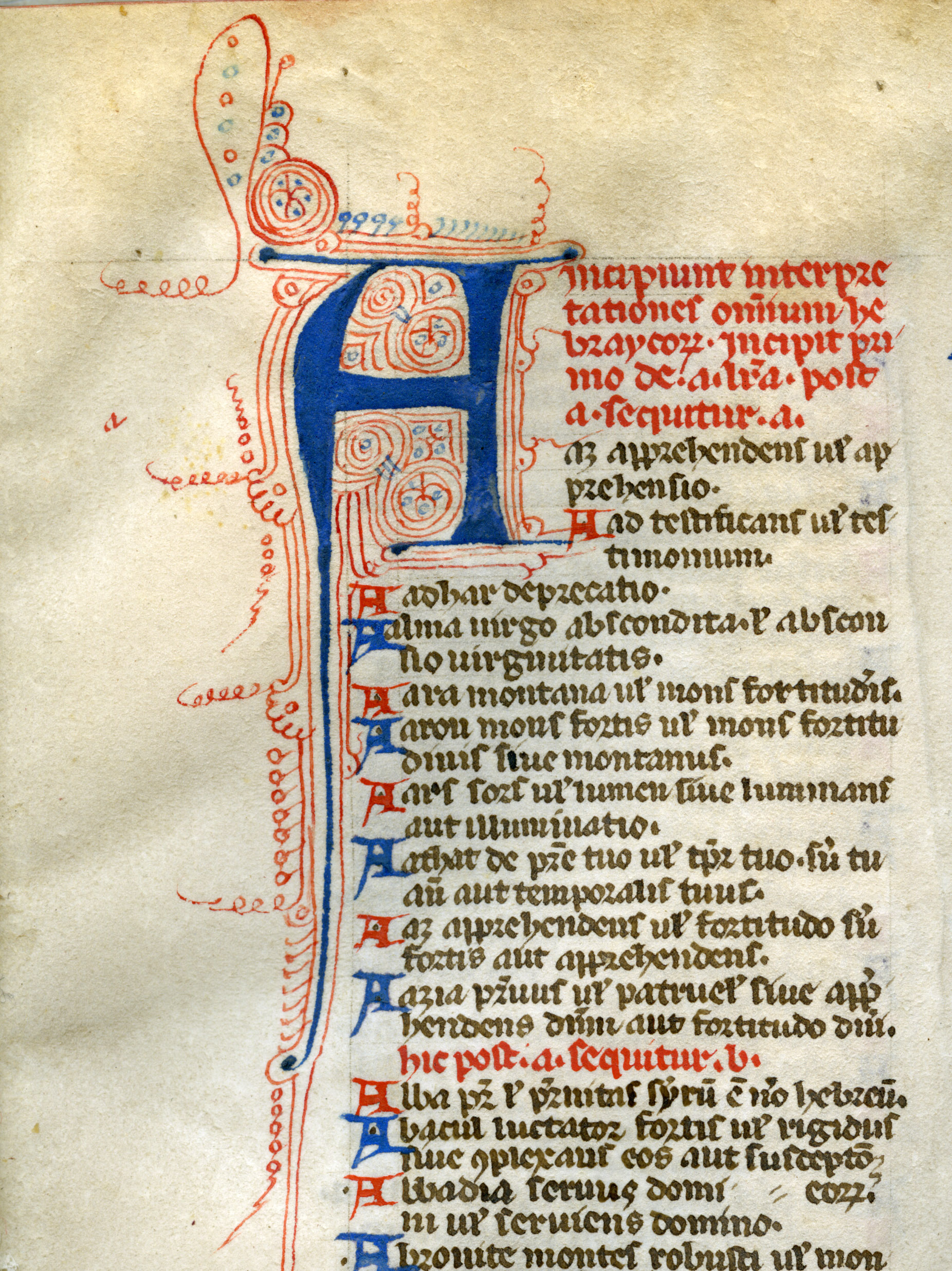Incipiunt interpretationes nominum hebraycorum

Preparing to translate the Bible from Hebrew into Latin, St. Jerome relocated to Palestine, where in 388, he began, as he wrote, to “set forth a book of Hebrew Names, classing them under their initial letters, and placing the etymology of each at the side.” His Interpretationes nominum Hebraeorum (Interpretations of Hebrew Names) enjoyed wide popularity throughout the Middle Ages and was a regular part of early medieval Gospel books as an exegetical aid.
This incomplete copy of the Interpretation of Hebrew Names begins with “A[h]az apprehendens” and continues through “Tirus angustia v[e]l tribulatio s[i]v[e] plasmatio aut fortitudo.” Internal evidence suggests that it was once part of a larger manuscript, presumably a Bible.
Background
Preparing to translate the Bible from Hebrew into Latin, St. Jerome relocated to Palestine, where in 388, he began, as he wrote, to “set forth a book of Hebrew Names, classing them under their initial letters, and placing the etymology of each at the side.” His Interpretationes nominum Hebraeorum (Interpretations of Hebrew Names) enjoyed wide popularity throughout the Middle Ages and was a regular part of early medieval Gospel books as an exegetical aid.
The wide variety of medieval adaptations of the Interpretation of Hebrew Names, according to historian Eyal Poleg, can be grouped into three major renditions distinguished by their first entry: Adam, Aaron, or Aaz, the last being the most popular. Poleg concludes that the Interpretation evolved along with the new preaching style in the middle ages, providing clergy with a high degree of flexibility in weaving their own interpretations into the biblical text, regardless of whether their approach was literal, allegorical, anagogical, or tropological. He adds that the Aaz version especially can be seen less as an aid for understanding the biblical narrative than as a framework that “creates a tension between the original text and the interpretation of the word, a tension that could then be utilised by readers, exegetes or preachers for their own needs.”
Contents of Collection
This incomplete copy of the Interpretation of Hebrew Names begins with “A[h]az apprehendens” and continues through “Tirus angustia v[e]l tribulatio s[i]v[e] plasmatio aut fortitudo.” Written brown ink in a gothic book hand in double columns of 61 lines, ruled lightly with ink, the manuscript begins with an eight-line initial ‘A’ in blue with red decorations, with three-line initials each time the second letter changes and alternating red and blue (one-line) initials supplied by a rubricator. Guidance to the rubricator was provided by the scribe in two forms: first with a minuscule letter in brown or red, and second with a verbal directive in red in a form such as “Incipiunt per ‘c’ & post ‘c’ sequitur ‘a.'”
Rectos of the 1st, 13th, 25th, and 37th leaves are numbered in Arabic numbers in ink in the lower left corners (in a different, apparently later hand) 32-35 respectively. Versos of 12th, 24th, and 36th leaves contain catchwords in the lower right corners. The manuscript therefore consists of three full 12-leaf quires (32-34) plus the first two leaves of the following quire (35), suggesting strongly that these surviving leaves were once preceded by 31 quires (372 leaves), and that they may have been part of the apparatus of a Bible.
The manuscript is bound in late 20th-century marbled boards, with a red morocco label on the front cover: Interpretations of Hebrew names / Manuscript on vellum / France 13th century.” The scribe erred in recording the title, writing “omnium” instead of “nominum.”
Administrative information
Access
The collection is open for research.
Language:
Provenance
Acquired from Bernard Quaritch, 1988.
Processing Information
Processed by I. Eliot Wentworth, June 2017.
Bibliography
Eyal Poleg, The Interpretation of Hebrew Names in theory and practice, in E. Poleg and L. Light (eds.), Form and Function in the Late Medieval Bible, vol. 27, Library of the Written Word, vol. 27.
Copyright and Use (More information )
)
Cite as: Incipiunt interpretationes nominum hebraycorum (MS 955). Special Collections and University Archives, University of Massachusetts Amherst Libraries.
